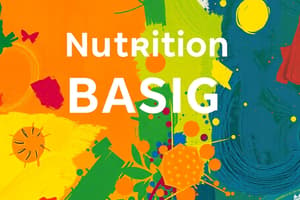Podcast
Questions and Answers
What is a calorie?
What is a calorie?
A calorie is a unit of measure of the amount of energy in a food.
What are nutrients?
What are nutrients?
Nutrients are chemical substances present in food that are used by the body to sustain growth and health.
What are the 6 types of nutrients?
What are the 6 types of nutrients?
Carbohydrates, proteins, fats, water, vitamins, minerals.
What are phytochemicals?
What are phytochemicals?
What does RDA stand for?
What does RDA stand for?
What does AI stand for in nutrition?
What does AI stand for in nutrition?
What does UL represent?
What does UL represent?
What is the Ripple Effect in nutrition?
What is the Ripple Effect in nutrition?
What are empty calories?
What are empty calories?
What is the difference between essential and non-essential nutrients?
What is the difference between essential and non-essential nutrients?
What factors affect nutrient needs of the body?
What factors affect nutrient needs of the body?
What is metabolic harmony?
What is metabolic harmony?
Define nutrient dense and give examples.
Define nutrient dense and give examples.
How does a nutrient deficiency develop?
How does a nutrient deficiency develop?
List 3 things that can lead to malnutrition.
List 3 things that can lead to malnutrition.
Which groups are at greater risk for malnutrition?
Which groups are at greater risk for malnutrition?
Flashcards are hidden until you start studying
Study Notes
Calorie
- Unit of measure for energy provided by food.
- Not a nutrient itself; indicates energy transfer to the consumer.
Nutrient
- Chemical substances from food crucial for growth and health maintenance.
Types of Nutrients
- Six main categories: carbohydrates, proteins, fats, water, vitamins, and minerals.
Phytochemicals
- Plant-derived chemicals with various functions in the human body.
- Known for providing color, flavor, growth support, and protection against pests and diseases.
Recommended Daily Allowance (RDA)
- Guidelines established in 1943 to address nutritional needs following WWII.
Adequate Intake (AI)
- Used for nutrients lacking sufficient research to establish RDA, such as calcium and vitamin D.
Tolerable Upper Intake Levels (UL)
- Maximum daily nutrient intake levels to prevent toxicity.
- Not recommended intake levels, but safe caps for consumption.
Ripple Effect
- Dietary changes lead to modifications in the intake of various nutrients.
- For example, a low-fat diet may lower caloric and vitamin E intake alongside fat reduction.
Empty Calories
- Foods offering high caloric value with minimal nutrient density.
- Common examples include soft drinks, candy, alcohol, and excess animal fats.
Essential vs Non-Essential Nutrients
- Essential nutrients, when deficient, cause specific deficiency diseases.
- Non-essential nutrients do not lead to diseases upon inadequate intake.
Factors Affecting Nutrient Needs
- Influenced by age, sex, body size, growth stages, genetics, disease states, pregnancy, breastfeeding, and environmental exposures.
Metabolic Harmony
- Optimal health and longevity depend on balanced nutrient availability.
- Disruptions can lead to diseases affecting various body systems.
Nutrient Density
- Foods high in nutrients relative to their calorie content.
- Examples include broccoli, collards, lean meats, and cantaloupe.
Development of Nutrient Deficiency
- Prolonged inadequate intake depletes the body's nutrient reserves.
- Resulting in diminished blood levels of the nutrient.
Causes of Malnutrition
- Can arise from poor diet, disease, genetic issues, or a combination of factors.
Groups at Greater Risk for Malnutrition
- At-risk groups include pregnant women, infants, children, the elderly, sick individuals, and those recovering from illnesses.
Studying That Suits You
Use AI to generate personalized quizzes and flashcards to suit your learning preferences.





